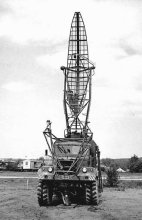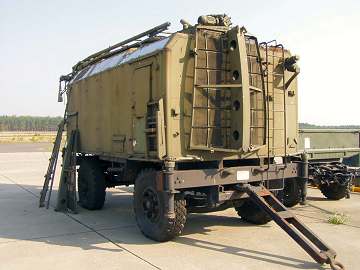PRV–9 “Thin Skin A”
Description of the radar set, tactical-technical characteristics

Figure 1: PRV–9A of Czech Republik, carried by a truck “KraZ-214” (Source: www.army.cz)

| Specifications | |
|---|---|
| frequency: | 5 to 9 GHz |
| pulse repetition time (PRT): | 1.6 and 2.5 ms |
| pulse repetition frequency (PRF): | 400 and 800 pps |
| pulsewidth (τ): | 1 and 1.7 µs |
| receive time: | |
| dead time: | |
| peak power: | 700 kW |
| average power: | 470 W |
| instrumented range: | 200 to 300 km |
| range resolution: | 1.5 km |
| beamwidth β: | 1.5° |
| beamwidth ε: | 0.4° |
| hits per scan: | |
| MTBCF: | |
| MTTR: | |
PRV–9 “Thin Skin A”
Russian designator: “Наклон-2”, A nodding height-finder of the states of the former Warsaw pact. It was used for measuring of the elevation angle and height calculation in low, middle and large heights for short to medium range. The height determination was assigned over an automatic radar guidance system (AFLS), by a primary surveillance radar, or simple “voice controlled” from a command post.
The PRV–9 and its power supply was developed on two trailer, a transmitter/receiver cabinet with the antenna's turn table, and a cabinet with the independent electric power generator (diesel-engine). A synchronization with strange trigger pulses and synchro-voltages was possible. The PRV–9 was fast moveable, the crew could erect the equipment within 45 minutes. Its radar scope (RHI-scope) with its remote facilities could be operational in a distance up to 300 m, as a set-top equipment on a PPI-Scope of a primary surveillance radar, a P-15 (Nato-code “Flat Face A”) often. The vertical elevation angles were covered from 0° to +20° by a mechanical nodding. A horizontal search from 0° to 360° in synchronous turn to another primary radar set was possible in a defined elevation angle was used to detect extremely low flyingly aims.
The accuracy in the height determination was about ±100 m, in the bearing angle measurung at ±2°, and in the distance measuring at ±1000 m. A refraction dependent correction of the height calculation was made by use of an equivalent temperature Tequiv as a correction factor in the formula for the height determination. The size of the equivalent temperature was determined by automatic measuring of temperature and air pressure near ground at the location of the radar site. An auxiliary quantity A is calculated from the equivalent temperature, with which the trigonometrical height Htrigon could be changed to the corrected height Hcorr:


where r the determinated by runtime measuring slant range,
R the earth radius (6
ε, the measured elevation angle.
The PRV–9 was fitted with a protection system against active and passive jamming. The storage of a pulse period for pulse-pair processing was carried out with two memory tubes with spiral scanning deflection. A triple staggered Pulse repetition Frequency (PRF) and a wide area of manual or automatic transmitter's frequency agility guaranteed a relatively insensitivity against active attempts of jamming.
This height-finder also was based on a truck "KraZ 214" (instead on a trailer) and then named as PRV–9A.

Figure 2: transmitter/receiver cabinet of PRV–9 in the Museum of German Air Force (Berlin-Gatow)
